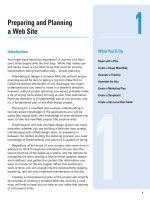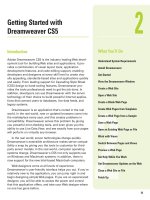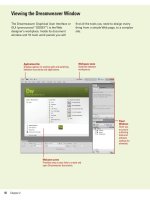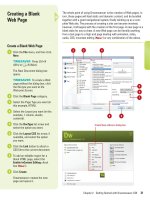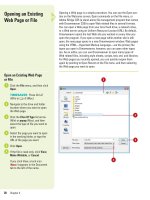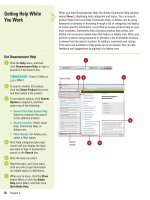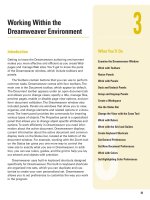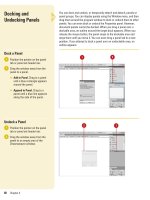adobe dreamweaver cs5 on demand part 45 pptx
Bạn đang xem bản rút gọn của tài liệu. Xem và tải ngay bản đầy đủ của tài liệu tại đây (689.6 KB, 7 trang )
ptg
272 Chapter 11
As mentioned before, frameset documents are simply individual HTML
documents, with all the rights and privileges of any other HTML docu-
ment. They can have any content; including tables and layers, and they
have the same properties of any other HTML document, such as: back-
grounds, margins, headings, etc. You can change the properties of a
HTML document destined to be displayed within a frameset in one of
two ways. The first is to open the document directly in Dreamweaver,
make any changes, and then save the document. When it's opened
within the frameset, the changes to the properties will be displayed as
ordered by you. The second way is to change their properties while
viewing the document within the frameset (recommended). Since the
procedure is basically the same, we'll examine the changing of page
properties while viewing the document in the frameset.
Changing Frame
Properties
Change Page Properties for a
Frame Document
Open the Web page with the
frameset you want to modify.
Right-click (Win) or Control-click
(Mac) the HTML frame document
that you want to modify, and then
click Page Properties.
Select from the following Page
Properties options:
◆ Appearance (CSS) or
Appearance (HTML). Select to
change the overall appearance
of the page; including
background, text and margins.
◆ Links (CSS). Select to change
linking information; link colors
and fonts and underlining.
◆ Headings (CSS). Select to
modify the heading font, color
and size.
◆ Title/Encoding. Select to modify
the title and encoding of the
page (this information is used by
browsers to help properly
display the page).
◆ Tracing Image. Select to add or
modify a tracing image.
Click OK.
4
3
2
1
1
2
4
3
From the Library of Wow! eBook
ptg
Chapter 11 Creating Frames 273
Change Frame Properties
Open the Web page with the
frameset you want to modify.
Select the frame you want to
modify in the Frames panel or
Shift-Alt-click (Win) or Shift-
Option-click (Mac) the frame in
Design view.
◆ You can also click a frame in
the Frames panel.
Open the Properties panel.
Select from the following Frame
Properties options:
◆ Frame Name. Enter the name
you want used by a link’s target
attribute or by a script to refer
to a frame. A frame name must
start with a letter and it’s case-
sensitive.
◆ Scr. Specifies the source
document to display in the
frame.
◆ Scroll. Click to select a scroll
display option: No (hide), Yes
(show), Auto (only when
needed), or Default (dictated by
browser).
◆ No Resize. Select to prevent
visitors from dragging frame
borders in a browser.
◆ Borders. Click to select a
border display option: No
(hide), Yes (show), or Default
(dictated by browser).
◆ Border Color. Click to select a
color for the frame borders.
◆ Margin Width. Specify the
width in pixels of the left and
right margins.
◆ Margin Height. Specify the
height in pixels of the top and
bottom margins.
4
3
2
1
3
1
4
2
Frames panel
From the Library of Wow! eBook
ptg
274 Chapter 11
Changing Frameset
Properties
Modify Frameset Border
Properties
Open the Web page with the
frameset you want to modify.
Click the View menu, point to
Visual Aids, and then click Frame
Borders to display visual borders.
Open the Properties panel, and
then expand it.
Click one of the frame borders to
select the frameset.
Modify the frames using the
options in the Properties panel:
◆ Border Window. Click to select
the specific frame (row/column)
you want to modify.
◆ Borders. Click to select border
displays option you want: No
(hide border), Yes (show border),
or Default (dictated by browser).
◆ Border Width. Enter a value (in
pixels) for the width of the
borders.
◆ Border Color. Click to select a
color for the borders.
5
4
3
2
1
In addition to setting properties for the individual frames and frame
documents, you can also set properties for the frameset. After you
select the frameset, you can use the Properties panel to view and set
frameset properties. The available options allow you to change border
and frame sizes. You can show or hide borders, change border width
and color, and set the frame sizes for rows and columns of the frame-
set. The RowCol Selection area in the Properties panel provides tabs
on the left side and top to select a frame. After you select a frame, you
can set the frame height and width you want in the Value box and how
much space the browser allocates to each frame in the Units list arrow.
You can set these options for each frame you select. In the Document
window, you can also change the frameset title.
3
1
5
2
4
Frames panel
From the Library of Wow! eBook
ptg
Chapter 11 Creating Frames 275
Modify Frameset Size Properties
Open the Web page with the
frameset you want to modify.
Click the View menu, point to
Visual Aids, and then click Frame
Borders to display visual borders.
Open the Properties panel, and
then expand it.
Click one of the frame borders to
select the frameset.
Click a tab on the left side or top of
the Row/Col Selection area to
select the frame you want to set
the Value and Units below.
Enter a value to determine the
height or width of the frame.
Click the Units list arrow, and then
select the measurement units for
the Row/Column value you want:
◆ Pixels. Sets the size of the
column or row to an absolute
value. Typically used with a
left-side frame.
◆ Percent. Sets the column or
row to be a percentage the
total width or height of its
frameset.
◆ Relative. Allocates the
available space after Pixels to
the selected column or row.
Typically used with a right-side
frame.
7
6
5
4
3
2
1
3
1
5
2
4
6
7
Did You Know?
You can set the title for a frameset
page.
Open the page, select the frame-
set in Design view, and then type a
name for the frameset in the Title box
on the Document toolbar. When a visi-
tor opens the frameset page in a
browser, the title appears in the
browser’s title bar.
From the Library of Wow! eBook
ptg
276 Chapter 11
Thus far, this chapter has dealt with the creation of frameset docu-
ments, and the adding and saving of Web data on the individual HTML
pages. However, the real power of frames is their ability to load new
pages into selected frames, based on an available link. For example,
you could be a photographer that wants people to see your images
(and hopefully buy them). You create a two-framed Web document that
has links to your images on the left. When you click on a link, the frame
on the right changes to display a large example of your photographic
talent. To use a link in one frame to open a document in another frame,
you need to set a target for the link. The target instructs the browser
into which frame to place the new document. When a visitor clicks the
link, the specified content opens in the specified frame.
Targeting Links
Create a Targeted Link
Open the Web page with the
frameset you want to create a
targeted link.
Select the object or text to be
converted into a targeted link.
Open the Properties panel.
Create the link to the new
document using one of the
following methods:
◆ Click the folder icon, and then
select the link file.
◆ Drag the Point to File icon to the
Files panel to select the link file.
Click the Target list arrow, and then
select the target frame name (at
the bottom of the list), or select
from the following options.
◆ _blank. Opens the linked
document in a new browser
window, leaving the current
window untouched.
◆ _parent. Opens the linked
document in the parent frameset
of the frame the link appears in,
replacing the entire frameset.
5
4
3
2
1
3
6
1
2
54
From the Library of Wow! eBook
ptg
Chapter 11 Creating Frames 277
◆ _self. Opens the link in the
current frame, replacing the
content in that frame.
◆ _top. Opens the linked
document in the current
browser window, replacing all
frames.
IMPORTANT
Frame names
appear when you're editing the
document within a frameset. When
you edit a document in its own
window, frame names do not
appear in the Target menu. If you're
editing a document outside of the
frameset, you can type the target
frame's name in the Target text box.
Click the File menu, point to
Preview In Browser, and then
select a browser of your choice to
test the document.
6
Preview in a browser;
click to test link.
From the Library of Wow! eBook
ptg
278 Chapter 11
This method is great for those Web sites that contain a lot of links to a
lot of boring text documents. To make this process work, the name of
the HTML document should be the name you want for the link; for
example, formatting.html, or frame_help.html. The documents are the
standard HTML type: graphics, text… the whole nine yards. You just
want to create a simple, almost file folder kind of page, where a visitor
clicks on a link, and it loads the appropriate page in another frame.
Creating Quick and
Easy Frame Links
Create Quick and Easy Frame
Links
Create a frameset document with
two frames: one for the links, and
one for the documents. Name them
links and documents.
Open the Files panel and display all
the HTML documents that you want
to use as links.
Drag and drop one of the files from
the Files panel into the links frame
(it appears as an underlined link).
NOTE
If the original name of the
HTML document is
document_1.html, the linked text
will be document_1, without the
HTML extension.
Select the linked text.
Click the Target list arrow in the
Properties panel, and then select
the content frame name as the
target for this file.
Repeat steps 3-5 until you have all
your documents displayed as links.
Click the File menu, point to
Preview In Browser, and then
select a browser of your choice to
test the document.
NOTE
If you don’t like the file
name as the link name, you can
always select the file name in the
links frames and change it. The
change in name will not affect the
link to the file.
7
6
5
4
3
2
1
5
6
Links frame
1
4
3
2
From the Library of Wow! eBook
